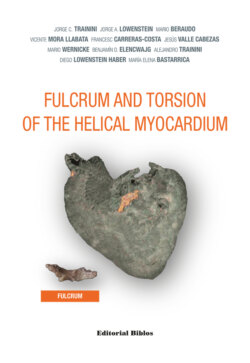Fulcrum and Torsion of the Helical Myocardium

Реклама. ООО «ЛитРес», ИНН: 7719571260.
Оглавление
Jorge C. Trainini. Fulcrum and Torsion of the Helical Myocardium
FULCRUM AND TORSION OF THE HELICAL MYOCARDIUM
Index
Abbreviations
Prologue
Preface
Research Hypothesis
Proposition I. Support and Functional Anatomy of the Heart. The helical myocardium. 1. Phylogenetic aspects of the circulatory system
2. Continuous myocardium
3. Myocardial architecture
The cardiac apex
4. Topography of the continuous myocardium
5. Anatomical dissection of the myocardium
Results
Discussion
Conclusions
6. Free ventricular wall
7. The friction mechanism in myocardial torsion-detorsion
8. Proposition I. Summary
Proposition II. Research on cardiac electrical propagation. 1. Historical and analogical concepts on myocardial electrical activation
2. Research on cardiac electrical activation
Results
Interpretation
3. Stimulus propagation and left ventricular torsion
4. Electrocardiographic correlation
5. Proposition II. Summary
Proposition III. Helical cardiodynamics. Suction pump. 1. Cardiac mechanics
2. Chronology of the ventricular suction mechanism ideas
3. Active protodiastolic suction phase
4. Negative intraventricular pressure and suction mechanism
5. Experimental research on left ventricular suction
Material and methods
Results
Discussion
Conclusions
6. Electrophysiological investigation on cardiac suction
7. Cardiac energy
Considerations on the energy concept
Calculations of Cardiac Energy
8. Congestion
Ejection and suction cardiac energy index
9. Considerations on a clinical model of ventricular mechanical containment
10. Intraventricular vortex
11. Proposition III. Summary
Proposition IV. Contributions of Echocardiography and Cardiac Magnetic Resonance to the study of the helicalheart. 1. Echocardiography of myocardial torsion
2. Cardiac Magnetic Resonance Imaging
Study of ventricular torsion
CMR by diffusion tensor imaging: anatomical dissection without obstacles
Identification of myocardial fiber arrangement by diffusion tensor CMR
Parameters derived from CMR images
Effect of ventricular torsion on cardiovascular flow dynamics
Hemodynamic forces
3. Proposition IV. Summary
Conclusions
References
Videos
Authors
Отрывок из книги
In this new book, Trainini and his team attempt a step forward and make a series of proposals that come to complete cardiac anatomy, physiology and mechanics. Reading this new investigation is a pleasure that demands continuous attention, so that our “neuronal boxes” do not rebel against the effort it means to sometimes destroy what we have firmly installed in them. The text should be read slowly, as it was never easy to tread in swamp-limited grounds and, as in the ascent to the summit of a difficult mountain, stop now and then to take a breath and enjoy the view as we get near the peak, where we will see the final landscape of the new vision. Then we will be conscious that the effort was worthwhile.
In the first proposition of the research the authors study the anatomical and histological study of the myocardium, which defines a continuous, spiraling muscle, an integral piece that in order to fulfill its muscle function needs a supporting point, the cardiac fulcrum. The myocardium is inserted at its origin and end into this nucleus with tendinous, cartilaginous and even osseus structure, according to the specimen analyzed, located below and in front of the aorta. In this first proposition, splendidly documented, there is also an important contribution regarding the friction generated between the muscle layers in the mechanism of cardiac contraction
.....
LVSWI: Left ventricular systolic work index
MAP: Mean arterial pressure
.....